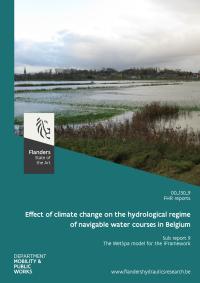Gedaan met laden. U bevindt zich op: Effect of climate change on the hydrological regime of navigable water courses in Belgium. Sub report 9. The WetSpa model for the iFramework
Effect of climate change on the hydrological regime of navigable water courses in Belgium. Sub report 9. The WetSpa model for the iFramework
The assessment of climate change impact on the hydrological system is becoming more and more a key issue for establishing best management practices for the limited water resources. Climate change impact analysis requires state of the art hydrological models to perform simulations of different climate scenarios. The study of these scenarios is however not sufficient to compensate for the high uncertainty of future forecasting. With the purpose of including model structure uncertainty, the iFramework was developed (Pannemans et al., 2014). This Python-based framework is a powerful platform for managing and creating flexible hydrological models. Within the iFramework, three well known lumped hydrological models can be used: NAM, PDM and VHM. The available tools have however a lumped model structure which can be a limiting factor for complex hydrological applications. To overcome this limitation, we extended the library of hydrological tools by including the spatially-distributed model WetSpa in the iFramework toolbox. This report describes the development of a iFramework-compatible WetSpa model, and its implementation and testing by means of theoretical and real case study. The WetSpa model (Water and energy transfer between Soil plant and atmosphere) is a well established GIS-based, spatially-distributed rainfall-runoff model for hydrological simulations at the catchment scale. Recently a process-based Python version of the model has been developed (Salvadore, E. et al., 2012, 2014), this new version is based on a different Python framework (Schmitz, et al. 2013a, 2013b) but facilitates the integration with the iFramework. To perform the integration, we carried out an in-depth comparison of the two framework paradigms to identify the appropriate strategy to bridge the gaps between the two frameworks. Afterwards, we developed new Python codes for the WetSpa model in the iFramework and we modified some parts of the iFramework to allow the integration of the WetSpa model in the toolbox. In this phase, we decided to develop two versions of the WetSpa model: a spatially-distributed and a lumped version. Distributed and lumped WetSpa models share the same Python codes, the main difference is the flow routing approach. Finally, these two versions were verified by means of a theoretical and a real case study. We compared the results generated by the two model versions with the original WetSpa-Python model. In both validation tests, the spatially-distributed model produced nearly identical results to the original model, with only negligible rounding errors. In the lumped model, all the inputs and parameters were averaged over the all catchment. The validation of the lumped model is less straightforward as model parameters partially lose their physical meaning and cannot be directly compared with the distributed ones. However, by modifying a number of parameters we were able to achieve a good match between the lumped model and the original spatially-distributed model, which ensure the correct implementation of the model code. Further tests on the lumped model are however required for a better understanding of the behavior of the model parameters.

Lees de publicatie
- Publicatiedatum
- Juni 2022
- Publicatietype
- Onderzoeksrapport
- Thema's
- Scheepvaart en havens
- Auteur(s)
- E. Salvadore, J. Nossent, F. Pereira, F. Mostaert
- Reeks
- FHR reports 00_130_9